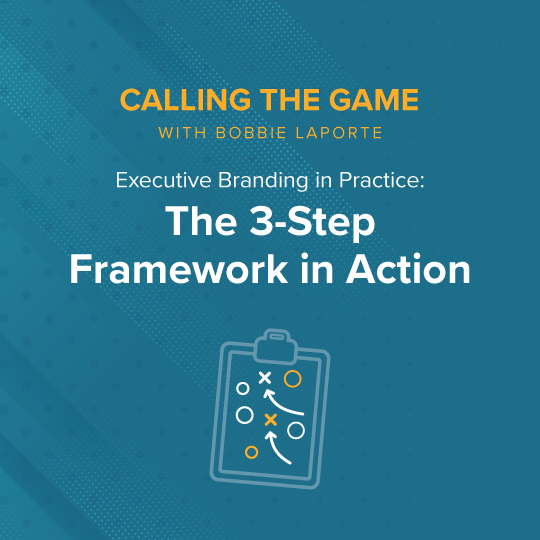Following up on her video series on Executive Branding and Self Promotion, Bobbie LaPorte’s March 26 “Calling the Game” video follows up with a real-life example of one of her clients. Learn how this Engineering leader successfully implemented her own personal brand to build her career—while supporting and inspiring those around her.
Enhancing Your Leadership Through Strategic Brand Development and Real-World Implementation
Hi, this is Bobbie LaPorte, back with another week of “Calling the Game,” where I share my own experience and insights while giving you valuable tools you can use to call your own game…and plan the best moves for you and your team.
I recently completed a 3-part series here on Executive Branding and Self-Promotion, a sensitive subject for many leaders. The response to the series was very positive, so I’ve decided to follow up with an example of how to use the 3-step framework I shared for developing your brand: What – For Whom – How
What you do/deliver/the impact you have as a professional
Who you do it for – your audience, clients, stakeholders
How you do this that is different from your peers – this is the emotional connection that people make to you
Executive branding example: putting the 3-step framework into practice
Here is my example:
One of my clients is an Engineering leader who’s had significant success in diverse companies by having her teams focus on client needs first, vs. producing “cool” technical stuff…sounds pretty straightforward but it often doesn’t happen that way.
With this client-centric focus, she has progressed from an Engineering leader to a Product Leader, to a General Manager and then Chief Product Officer. Pretty impressive achievement.
Along her career journey, she has always been known as a leader who puts people first. She takes the time to learn about their unique skills and talents, career aspirations, and needs. She invests in and develops them. She lets them know she cares about them as people.
And she’s not afraid to admit she doesn’t have all the answers. She seeks input, is approachable, and is open to new ways of doing things.
As a result, her teams have consistently far exceeded the value contribution of their peers; highly talented people have sought her out to work with her, and her own career satisfaction has soared.
Now, did she discover all this overnight?
Of course not, but she possessed the curiosity and self-awareness to reflect on how her own success was achieved, to uncover the strengths and assets she brought to her job, and how she did her work that differentiates her from other executives in similar roles.
Her personal brand statement went something like this:
“At heart, I am a builder. I build world-class software products, the processes that sustain them and – most importantly – the people who make it all possible.”
I have seen her operationalize her brand by intentionally bringing it forward when she takes on a new challenge, recruits new team members, and directs her team on critical projects.
And that has served her and the people she has inspired well.
So don’t be afraid to do a formal inventory of your skills and talents; to reflect on the personal attributes you fall back on time and again when you are challenged, to define the “HOW” you do your work. I think you will be pleased at how far it will take you in developing your personal brand.
Okay, that’s it for this week’s “Calling the Game.” I hope this helps you gear up for a great week and navigate any curveballs that may come your way!
In case you missed my series Navigating Executive Branding:
Part 1: Embrace Authentic Self-Promotion


